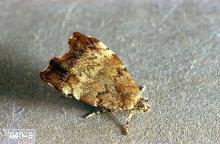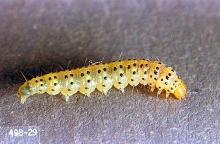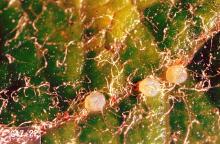Choreutis pariana
Pest description and damage The adult moth is reddish brown, with a wingspread less than 0.5 inch, and irregular light and dark bands on the wings. Larvae are 0.5 inch in length, yellowish to greenish, with black spots and a yellow-brown head. Pupae are yellow to brown with a white silken cocoon. The larvae skeletonize and roll leaves from the sides. Damaged leaves are brown and papery and drop prematurely. They feed on apple, crabapple, cherry, pear, mountain ash, birch, plum, hawthorn and possibly willow, but apple is the preferred host. Damage varies from inconsequential to serious, so early tree monitoring to assess larval numbers is an important management tool.
Biology and life history Adult moths overwinter in crevices in the tree. They lay eggs in small bunches on the undersides of leaves. The larvae emerge and feed on the underside of the leaves, then move to the top surface and feed there. There is often more than one caterpillar in the roll. After three to four weeks, they pupate in the rolled leaf. Adults emerge after about two weeks to start a new generation. There are at least two generations per year.
Pest monitoring Watch for signs of skeletonizing that, from a distance, looks like the leaf tips have been burned. Early scouting will provide adequate time for control if numbers are high.
Management-biological control
There are many natural enemies of this pest. Avoid broad-spectrum sprays that would disrupt this system.
Management-cultural control
Larvae and pupae are removed easily from rolled leaves. Rolled leaves are pinched to kill larvae on small trees. Remove heavily infested twigs.
Management-chemical control
See Table 2 in:
Chemical Control of Landscape Pests
For more information
See "Caterpillar" in:





